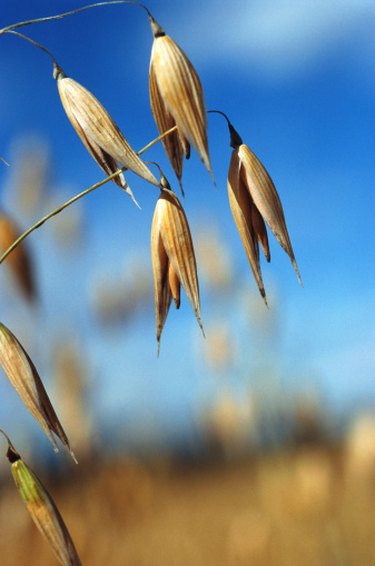
Farmers aren't the only ones who can grow oats (Avena sativa). More and more people who have the space opt to do this and find that it can be a rewarding endeavor. This grain is used in oatmeal and oat flour, and you can also use it in breads and baked goods. Horses and cattle also eat oats, and you will find products that contain oats, like Aveeno skin lotion, because oat extract can be very soothing on the skin. How does one go about growing oats, then?
Varieties of Oats
Video of the Day
If you have a 30 by 30-foot garden space, that is enough room to grow 2 1/2 bushels of oats. Common oats (Avena sativa) have rigid hulls and have to be threshed by hand or machine. They do well in acidic soil, making them a particular hardy option, and they mature in 100 to 120 days. Farmers widely use them as a cover crop. Naked oats (Avena nuda) have much softer hulls that are easier to remove. Streaker is one of the most popular varieties for growers.
Video of the Day
Forage oats (Avena sativa) are winter hardy and are best used to feed livestock or as a cover crop. Black oats (Avena strigose) can be used as a cover crop and food crop and to feed livestock. These are also called bristle oats and Japanese oats.
Where Are Oats Grown?
Oats are primarily grown in cool, temperate climates, and the top five countries in the world for oat production are the Russian Federation, the United States, Canada, Poland and Finland. Others include Australia, Argentina and Chile. Oats should be planted in full sun and placed 3 inches apart with 3 inches between rows. The plants can tolerate light frost but cannot survive temperatures that fall below 5 degrees Fahrenheit. Oat plants prefer well-draining soil with a pH between 6.0 and 7.5.
When can you plant oats? You should sow them in the soil in early spring, so in order to get the best results, you will need to till the garden plant in the fall to get it loose enough for planting in the early spring season. Spread out the seeds, till them shallowly and rake over some dirt. Seeds sitting on top will germinate if birds don't get to them.
How to Grow Oats
Keep the garden bed moist and water it when it is dry outside. Drip irrigation is a good option; it's best to water plants from the bottom to prevent fungal diseases. Weed often and add fertilizer if needed. Harvest the oats when they are about 3 feet tall; use a sickle or scythe to cut the stems with plant heads on them. This stem is called "oat straw." Let it dry on the ground for one or two days. Then, gather it into loose bundles and bring them to your work area.
Make groups of five pieces of oat straw and twist their pieces together to form ropes. Wrap these around the bundle and tuck in the ends. Stand these sheaves upright with the tops and bottoms flared out; these are now called shocks. This process can take one or two weeks for them to dry enough for threshing. Then, you can open the sheaves and spread them out on a flat, dry surface. Separate the hulls from the straw and use the latter to feed animals or for mulch.
If you want to eat the oats, place the hulls on a cookie sheet and bake them at 180 degrees for 90 minutes; they will break away from the edible parts (groats) inside. Use a roller mill to grind away the hulls, place these along with the groats into bushel baskets and cover them with mesh. On a dry, breezy day, you can separate (winnow) the hulls from the oats. Set out a large sheet and throw the oats and chaff into the air. The breeze will take the hulls, and the grains will fall. After collecting them, you'll want to keep them in a cool, dry place.